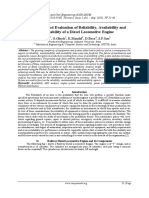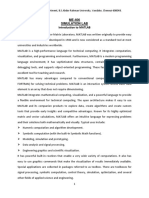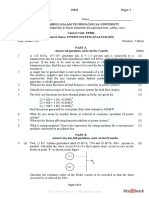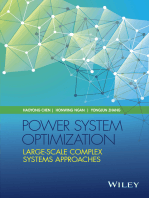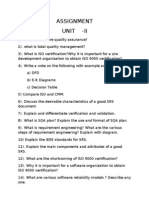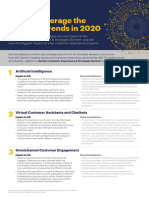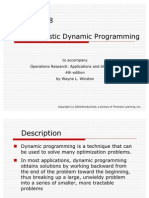Study of Model Predictive Control Using Ni Labview
Uploaded by
Brankko Jhonathan Torres SaavedraStudy of Model Predictive Control Using Ni Labview
Uploaded by
Brankko Jhonathan Torres SaavedraInternational Journal of Advanced Research in Engineering and Technology (IJARET), ISSNIN 0976 INTERNATIONAL JOURNAL OF ADVANCED RESEARCH 6480(Print),
, ISSN 0976 6499(Online) Volume 3, Number 2, July-December (2012), IAEME
ENGINEERING AND TECHNOLOGY (IJARET)
ISSN 0976 - 6480 (Print) ISSN 0976 - 6499 (Online) Volume 3, Issue 2, July-December (2012), pp. 257-266 IAEME: www.iaeme.com/ijaret.asp Journal Impact Factor (2012): 2.7078 (Calculated by GISI) www.jifactor.com
IJARET
IAEME
STUDY OF MODEL PREDICTIVE CONTROL USING NI LabVIEW
Dr.V.BALAJI
Principal cum Professor, Department of Electrical and Electronics Engineering Lord Ayyappa Institute of Engineering and Technology, Kanchipuram. India Email Id: balajieee79@gmail.com ABSTRACT This paper introduces the application of virtual instruments implemented using the national instruments LabView software with various objectives in control system engineering education. The main of this paper is to provide a better understanding in the performance of model predictive control (MPC). This current paper discuses how to create a MPC for a simple model, MPC simple model with time delay and MPC versus PID controller. The scope of this paper is to give an overview of the MPC implementation in LabVIEW. The simulated results clearly explain the performance of the MPC and the difference between MPC and PID controller. Keywords: Control systems, Graphical Programming, Model Predictive Control (MPC), NI LabVIEW, PID controller, Simulation, Software INTRODUCTION I Now a days control systems engineers in the industry are using computer aided control systems design for modeling, system identification and estimation. These make a way to study graphical programming software tools and also becoming indispensable for teaching control systems theory and its applications. By adopting simulations the students may easily visualize the effect of adjusting different parameters of a system and the overall performance of the system can be viewed. Moreover it would be a ideal if such tools are not only utilized in relevant industries but it also be taught in the classroom.NI Labview has proven to be an invaluable tool in decreasing development time in research, design, validation, production and manufacturing cost. The major advantages of labview include ease of learning, debugging, and simplicity of using interface, reliable performance and capability of controlling the equipment. In this paper it is demonstrated how to create a model predictive control for a first order system, first order system with time delay in a Lab VIEW environment and also explains virtually the difference between MPC and PID controller. The simulations are conducted using control design simulation tool box in a graphical programming environment. Section 2 of this research paper is brief introduction of Model Predictive control. Section 3 is about the introduction of NI Labview. Section 4 deals with implementation of MPC in Lab VIEW.
257
International Journal of Advanced Research in Engineering and Technology (IJARET), ISSN 0976 6480(Print), ISSN 0976 6499(Online) Volume 3, Number 2, July-December (2012), IAEME
Section 5 describes the simulation results of MPC. Section 6 is the conclusion of this research paper. Section 7 contains the reference used in this paper. INTRODUCTION TO MPC II Model Predictive Control, or MPC, is an advanced method of process control that has been in use in the process industries such as chemical plants and oil refineries. Model predictive controllers rely on dynamic models of the process, most often linear empirical models obtained by system identification. Model predictive control (MPC) refers to a class of computer control algorithms that utilize an explicit process model to predict the future response of a plant. At each control interval an MPC algorithm attempts to optimize future plant behavior by computing a sequence of future manipulated variable adjustments. The first input in the optimal sequence is then sent into the plant, and the entire calculation is repeated at subsequent control intervals. Model predictive control (MPC) is a technique that focuses on constructing controllers that can adjust the control action before a change in the output set point actually occurs. This predictive ability, when combined with traditional feedback operation, enables a controller to make adjustments that are smoother and closer to the optimal control action values. MPC consists of an optimization problem at each time instants, k. The main point of this optimization problem is to compute a new control input vector to be feed to the system, and at the same time take process constraints into considerations. An MPC algorithm consists of a Cost function, Constraints , Model of the process . I II INTRODUCTION TO NI LABVIEW SOFTWARE LabVIEW StandS for Laboratory Virtual Instrumentation Engineering Workbench. The Labview environment consists of two programming layers a front panel and a block diagram .The front panel is built with controls and indicators, which are the interactive input and output terminals of the VI respectively. LabVIEW has many built in functions such as I/O data communication, state charts, Mathematics, Signal Processing, System Identification and Estimation. Control Design Simulation Module. Using above mentioned functions of LabVIEW MPC Model was simulated. IV CONTROL DESIGN AND SIMULATION USING LABVIEW 4.1Model Construction The Control Design and Simulation and predictive control palette in LabVIEW is shown in figure 1 and 2 respectively.
Figure 1 The Control Design Palette in LabVIEW
258
International Journal of Advanced Research in Engineering and Technology (IJARET), ISSN 0976 6480(Print), ISSN 0976 6499(Online) Volume 3, Number 2, July-December (2012), IAEME
Figure 2 The Predictive Control Palette in LabVIEW The Model Construction Palette is shown in figure 3 and also shows how many types models is available in the control design and simulation module.
Figure 3 The Model Construction Palette The VIs in this section is used to construct various types of Models like State Space, Transfer Function, and Zero-Pole-Gain. The Construct State Space Model and Construct Transfer Function Model functions are shown in figure 4 and 5 respectively. We use the CD Create MPC Controller VI to create an MPC Controller. The MPC created on a state-space model. The CD implement MPC Controller is used to calculate the control values for each sampling time and it is implemented in a While Loop.
259
International Journal of Advanced Research in Engineering and Technology (IJARET), ISSN 0976 6480(Print), ISSN 0976 6499(Online) Volume 3, Number 2, July-December (2012), IAEME
4.2 CD Construct State Space Model
Figure 4 CD Construct State Space Model.VI The terminals for the function are shown above. If the Sampling Time terminal is not connected, the system is by default considered continuous. Connecting a value to Sampling Time will change the system to discrete time using the given sampling time. There are terminals for the A, B, C, and D matrices of the State Space model. Once LabVIEW creates the State-Space model (available at the output terminal), it can be used for other functions and can be converted into other forms. 4.3 CD Construct Transfer Function Model
Figure 5 CD Transfer Function Model.VI The terminals are shown above. The important terminals are the Numerator and Denominator. As in the previous case, once the model is created, it can either be displayed on the Front Panel or connected to other functions. 4.4 CONSTRUCTION OF PID ACADEMIC CONTROLLER The VI shown below shows how to create and display an PID Academic controller .ie standard parallel PID controller.
Figure 6 Block Diagram of PID Academic
260
International Journal of Advanced Research in Engineering and Technology (IJARET), ISSN 0976 6480(Print), ISSN 0976 6499(Online) Volume 3, Number 2, July-December (2012), IAEME
V SIMULATION OF MPC IN LabVIEW 5.1 First order Model In this section we will consider a first model using LabVIEW Consider a first order system given below.
Where T is the time constant for the system K is the pump gain We set T = 8s and K = 4 Substitute the values in the above equation we get
The front Panel diagram with a wave form a simple model is shown in the figure 7. .
Figure 7 Front panel Diagram for a Simple Model From the wave form we clearly understand the Performance of MPC how it moves to reach the set point.
261
International Journal of Advanced Research in Engineering and Technology (IJARET), ISSN 0976 6480(Print), ISSN 0976 6499(Online) Volume 3, Number 2, July-December (2012), IAEME
Constraints and Weighting
5.2 Model with Delay Time We consider the following system X = - 1/T + Ku (tWe set the values as Where ) =4
T = 8s and K = 4 and
= time delay
The MPC algorithm requires that the model is a linear state-space model, but the time delay causes problems. A solution could be to transform the differential equation we have to a transfer function. Then we can use built-in functions in LabVIEW to convert it to a linear state-space model. Applying LT to the above equation we get
H(s) = x(s)/u(s) Substitute the values as T = 8s and K = 4 and
= = 4 We get the final expression
H(s) = x(s)/u(s) =
The figure 8 shows the front panel diagram of a simple model with a time delay and also it shows how MPC reaches the set point with a time delay of 4 s.
262
International Journal of Advanced Research in Engineering and Technology (IJARET), ISSN 0976 6480(Print), ISSN 0976 6499(Online) Volume 3, Number 2, July-December (2012), IAEME
Figure 8 Front panel Diagram of a Simple Model with a Time Delay
Figure 9 MPC Parameters
5.3 MPC VS PID Controller
Figure 9a Front Panel Diagram of MPC Controller
263
International Journal of Advanced Research in Engineering and Technology (IJARET), ISSN 0976 6480(Print), ISSN 0976 6499(Online) Volume 3, Number 2, July-December (2012), IAEME
Figure 10 Front Panel Diagram of PID Controller
Figure 11 Block Diagram of MPC Controller
264
International Journal of Advanced Research in Engineering and Technology (IJARET), ISSN 0976 6480(Print), ISSN 0976 6499(Online) Volume 3, Number 2, July-December (2012), IAEME
Figure 12 Block Diagram of PID Controller From the waveforms of figure 9and 10 we see the main difference between a MPC controller and a more traditional PID controller. Another main difference between MPC and PID is that MPC can handle MIMO (Multiple Inputs, Multiple Outputs) systems, while PID is used for SISO systems (Single Input, Single Output). From the figure 9 & 10 we can analyze the difference MPC and PID Controller. The difference between them is summarized below
S.No 1. 2.
MPC Controller Constraints included in the design
PID Controller No knowledge about constraints
A mathematical model is not needed
A mathematical model is not needed
3. Improved process operation 4. A mathematical model is not needed A mathematical model is not needed Not optimal process operation
5. A mathematical model is not needed A mathematical model is not needed
Table 1 Difference between MPC and PID
265
International Journal of Advanced Research in Engineering and Technology (IJARET), ISSN 0976 6480(Print), ISSN 0976 6499(Online) Volume 3, Number 2, July-December (2012), IAEME
VI CONCLUSION The idea of Model Predictive Control Simulation using NI LabVIEW is being put into operation successfully. This paper clearly explained the depth of MPC implemented through LabVIEW. The results illustrate the performance of MPC and also clearly state the difference between the PID and MPC controller. These simulation results are useful to do the required modifications in control system industry for optimal control. VII REFERNCES [1] Erik Luther (2012), Introduction to Control Design and Simulation using LabVIEW Rice University, Houston, Texas. [2] Camacho E. F and Bordons C. (1999) Model Predictive Control, Springer, London. [3] Maciejowski J. M. (2002) Predictive Control with Constraint, Prentice Hall. [4] National Instruments, 2012. LabVIEW User Manual at http://www.ni.com/pdf/manuals. [5] http://techteach.no/labview/ by Finn Haugen. [6] http://zone.ni.com/devzone/cda/tut/p/id/6368 based on Prof. Dawn Tilburystutorials from University of Michigan. ABOUT THE AUTHOR Dr.V.BALAJI has 12 years of teaching experience. Now he is working as a principal in Lord Ayyappa Institute of Engineering and Technology, Kanchipuram. His current areas of research are model predictive control, process control, and Fuzzy and Neural Networks. He has published 26 research papers in national and international journals and conferences. He is a member of ISTE, IEEE , IAENG, IAOE and IACSIT.
266
You might also like
- Integration of Demand Response into the Electricity Chain: Challenges, Opportunities, and Smart Grid SolutionsFrom EverandIntegration of Demand Response into the Electricity Chain: Challenges, Opportunities, and Smart Grid SolutionsNo ratings yet
- Design Neural Network Predictive Controller in SimulinkNo ratings yetDesign Neural Network Predictive Controller in Simulink9 pages
- Sensorless MPPT Technique For Gridconnected PMSG Wind TurbineNo ratings yetSensorless MPPT Technique For Gridconnected PMSG Wind Turbine123 pages
- Five Phase Brushless DC Machine Direct Drive SysteNo ratings yetFive Phase Brushless DC Machine Direct Drive Syste10 pages
- Transient Response of Induction Machine Using MATLAB SimulinkNo ratings yetTransient Response of Induction Machine Using MATLAB Simulink63 pages
- Simulation of Electric Machine and Drive Systems Using Matlab and SimulinkNo ratings yetSimulation of Electric Machine and Drive Systems Using Matlab and Simulink17 pages
- Electric Drives Concepts and Applications by Vedam Subrahmanyam 0074603701 PDFNo ratings yetElectric Drives Concepts and Applications by Vedam Subrahmanyam 0074603701 PDF5 pages
- Mathematical Modelling of Linear Induction Motor50% (2)Mathematical Modelling of Linear Induction Motor4 pages
- Power System Deregulation - SVEC-19 - M.techNo ratings yetPower System Deregulation - SVEC-19 - M.tech2 pages
- 2018 April Power Systems Analysis - EE306-A - Ktu QbankNo ratings yet2018 April Power Systems Analysis - EE306-A - Ktu Qbank3 pages
- (ART) A Photovoltaic System Model For Matlab Simulink PDFNo ratings yet(ART) A Photovoltaic System Model For Matlab Simulink PDF5 pages
- Design and Implementation of Conveyor Belt Speed Control Using PID For Industrial Applications100% (1)Design and Implementation of Conveyor Belt Speed Control Using PID For Industrial Applications6 pages
- Ee65 - Design of Electrical Machines (2 Marks Questions and Answers) - Unit - INo ratings yetEe65 - Design of Electrical Machines (2 Marks Questions and Answers) - Unit - I18 pages
- Model Predictive Direct Torque Control Methods For SpeedNo ratings yetModel Predictive Direct Torque Control Methods For Speed25 pages
- UPFC (Phasor Model) - MATLAB & Simulink Example - MathWorks IndiaNo ratings yetUPFC (Phasor Model) - MATLAB & Simulink Example - MathWorks India2 pages
- Backward Forward Sweep Load Flow Algorithm For Radial Distribution SystemNo ratings yetBackward Forward Sweep Load Flow Algorithm For Radial Distribution System3 pages
- C Code Generation For A MATLAB Kalman Filtering Algorithm - MATLAB & Simulink Example - MathWorks IndiaNo ratings yetC Code Generation For A MATLAB Kalman Filtering Algorithm - MATLAB & Simulink Example - MathWorks India8 pages
- Module Information Module Title Electric Drives and Control Module Code MMD2511No ratings yetModule Information Module Title Electric Drives and Control Module Code MMD25114 pages
- Rr410203-Computer Methods in Power Systems FinalNo ratings yetRr410203-Computer Methods in Power Systems Final8 pages
- Simulation Analysis of 100Kw Grid Connected Photovoltaic System100% (1)Simulation Analysis of 100Kw Grid Connected Photovoltaic System33 pages
- Review of Pole Placement & Pole Zero Cancellation Method For Tuning PID Controller of A Digital Excitation Control SystemNo ratings yetReview of Pole Placement & Pole Zero Cancellation Method For Tuning PID Controller of A Digital Excitation Control System10 pages
- Mitra - Technical Guide On Composite Load ModelingNo ratings yetMitra - Technical Guide On Composite Load Modeling80 pages
- Comparison Between VR, PM and Hybrid Stepper MotorsNo ratings yetComparison Between VR, PM and Hybrid Stepper Motors2 pages
- Synopsis: "Hybrid Solar-Wind Charging Station For Electric Vehicle and Its Simulation"No ratings yetSynopsis: "Hybrid Solar-Wind Charging Station For Electric Vehicle and Its Simulation"9 pages
- Identification of Sags and Swells Using Pic MicrocontrollerNo ratings yetIdentification of Sags and Swells Using Pic Microcontroller6 pages
- Performance Analysis of Doubly-Fed Induction Generator (DFIG) - Based Wind Turbine With Sensored and Sensorless Vector ControlNo ratings yetPerformance Analysis of Doubly-Fed Induction Generator (DFIG) - Based Wind Turbine With Sensored and Sensorless Vector Control198 pages
- Introduction To Graph Theory: March 2011No ratings yetIntroduction To Graph Theory: March 201111 pages
- Ee 0403 Power System Operation and Control: Dr. R.Jegatheesan Professor, EEE Department SRM University100% (1)Ee 0403 Power System Operation and Control: Dr. R.Jegatheesan Professor, EEE Department SRM University26 pages
- Speed Control of DC Motor Using Sliding Mode Control ApproachNo ratings yetSpeed Control of DC Motor Using Sliding Mode Control Approach6 pages
- Simulation of Some Power System, Control System and Power Electronics Case Studies Using Matlab and PowerWorld SimulatorFrom EverandSimulation of Some Power System, Control System and Power Electronics Case Studies Using Matlab and PowerWorld SimulatorNo ratings yet
- Power System Optimization: Large-scale Complex Systems ApproachesFrom EverandPower System Optimization: Large-scale Complex Systems ApproachesNo ratings yet
- Transmission Lines in Digital and Analog Electronic Systems: Signal Integrity and CrosstalkFrom EverandTransmission Lines in Digital and Analog Electronic Systems: Signal Integrity and CrosstalkNo ratings yet
- Mechanical_system_PID_simulation_based_on_simulinkNo ratings yetMechanical_system_PID_simulation_based_on_simulink6 pages
- 2UEB000095 ACS 2000 4 KV MV Switchgear Specification Rev ANo ratings yet2UEB000095 ACS 2000 4 KV MV Switchgear Specification Rev A5 pages
- IG N E D: AAB MCT FLG AVP FLG MCT PLG AVP AVP MCT FLG C.Zamorano A.Verdugo GST GFS ABC FGRNo ratings yetIG N E D: AAB MCT FLG AVP FLG MCT PLG AVP AVP MCT FLG C.Zamorano A.Verdugo GST GFS ABC FGR1 page
- Introduction To Mechatronics: Lecture #1No ratings yetIntroduction To Mechatronics: Lecture #144 pages
- ASQ Auto Webinar Core Tools Slides 101203No ratings yetASQ Auto Webinar Core Tools Slides 10120383 pages
- Dynamics in A Discrete Prey-Predator System: M.Renisagayaraj, A.George Maria Selvam, M.MeganathanNo ratings yetDynamics in A Discrete Prey-Predator System: M.Renisagayaraj, A.George Maria Selvam, M.Meganathan5 pages
- Manual Controlador de Procesos Burkert 110100% (1)Manual Controlador de Procesos Burkert 11096 pages
- Data Flow Diagram: Presented by Your NameNo ratings yetData Flow Diagram: Presented by Your Name17 pages
- Comparison of Different DC Motor Positioning Control AlgorithmsNo ratings yetComparison of Different DC Motor Positioning Control Algorithms6 pages
- A Presentation By: Anubhav Saini Abhishek Arya Akshay Saini Anuj Kumar ECE (6 Sem)No ratings yetA Presentation By: Anubhav Saini Abhishek Arya Akshay Saini Anuj Kumar ECE (6 Sem)17 pages
- Robotics Engineering: ME 406T Unit-1 Robot Fundamentals Lecture-1100% (1)Robotics Engineering: ME 406T Unit-1 Robot Fundamentals Lecture-129 pages
- Integration of Demand Response into the Electricity Chain: Challenges, Opportunities, and Smart Grid SolutionsFrom EverandIntegration of Demand Response into the Electricity Chain: Challenges, Opportunities, and Smart Grid Solutions
- Design Neural Network Predictive Controller in SimulinkDesign Neural Network Predictive Controller in Simulink
- Sensorless MPPT Technique For Gridconnected PMSG Wind TurbineSensorless MPPT Technique For Gridconnected PMSG Wind Turbine
- Five Phase Brushless DC Machine Direct Drive SysteFive Phase Brushless DC Machine Direct Drive Syste
- Transient Response of Induction Machine Using MATLAB SimulinkTransient Response of Induction Machine Using MATLAB Simulink
- Simulation of Electric Machine and Drive Systems Using Matlab and SimulinkSimulation of Electric Machine and Drive Systems Using Matlab and Simulink
- Electric Drives Concepts and Applications by Vedam Subrahmanyam 0074603701 PDFElectric Drives Concepts and Applications by Vedam Subrahmanyam 0074603701 PDF
- 2018 April Power Systems Analysis - EE306-A - Ktu Qbank2018 April Power Systems Analysis - EE306-A - Ktu Qbank
- (ART) A Photovoltaic System Model For Matlab Simulink PDF(ART) A Photovoltaic System Model For Matlab Simulink PDF
- Design and Implementation of Conveyor Belt Speed Control Using PID For Industrial ApplicationsDesign and Implementation of Conveyor Belt Speed Control Using PID For Industrial Applications
- Ee65 - Design of Electrical Machines (2 Marks Questions and Answers) - Unit - IEe65 - Design of Electrical Machines (2 Marks Questions and Answers) - Unit - I
- Model Predictive Direct Torque Control Methods For SpeedModel Predictive Direct Torque Control Methods For Speed
- UPFC (Phasor Model) - MATLAB & Simulink Example - MathWorks IndiaUPFC (Phasor Model) - MATLAB & Simulink Example - MathWorks India
- Backward Forward Sweep Load Flow Algorithm For Radial Distribution SystemBackward Forward Sweep Load Flow Algorithm For Radial Distribution System
- C Code Generation For A MATLAB Kalman Filtering Algorithm - MATLAB & Simulink Example - MathWorks IndiaC Code Generation For A MATLAB Kalman Filtering Algorithm - MATLAB & Simulink Example - MathWorks India
- Module Information Module Title Electric Drives and Control Module Code MMD2511Module Information Module Title Electric Drives and Control Module Code MMD2511
- Simulation Analysis of 100Kw Grid Connected Photovoltaic SystemSimulation Analysis of 100Kw Grid Connected Photovoltaic System
- Review of Pole Placement & Pole Zero Cancellation Method For Tuning PID Controller of A Digital Excitation Control SystemReview of Pole Placement & Pole Zero Cancellation Method For Tuning PID Controller of A Digital Excitation Control System
- Mitra - Technical Guide On Composite Load ModelingMitra - Technical Guide On Composite Load Modeling
- Comparison Between VR, PM and Hybrid Stepper MotorsComparison Between VR, PM and Hybrid Stepper Motors
- Synopsis: "Hybrid Solar-Wind Charging Station For Electric Vehicle and Its Simulation"Synopsis: "Hybrid Solar-Wind Charging Station For Electric Vehicle and Its Simulation"
- Identification of Sags and Swells Using Pic MicrocontrollerIdentification of Sags and Swells Using Pic Microcontroller
- Performance Analysis of Doubly-Fed Induction Generator (DFIG) - Based Wind Turbine With Sensored and Sensorless Vector ControlPerformance Analysis of Doubly-Fed Induction Generator (DFIG) - Based Wind Turbine With Sensored and Sensorless Vector Control
- Ee 0403 Power System Operation and Control: Dr. R.Jegatheesan Professor, EEE Department SRM UniversityEe 0403 Power System Operation and Control: Dr. R.Jegatheesan Professor, EEE Department SRM University
- Speed Control of DC Motor Using Sliding Mode Control ApproachSpeed Control of DC Motor Using Sliding Mode Control Approach
- Computer Aided Design of Electrical MachinesFrom EverandComputer Aided Design of Electrical Machines
- Simulation of Some Power System, Control System and Power Electronics Case Studies Using Matlab and PowerWorld SimulatorFrom EverandSimulation of Some Power System, Control System and Power Electronics Case Studies Using Matlab and PowerWorld Simulator
- Power System Wide-area Stability Analysis and ControlFrom EverandPower System Wide-area Stability Analysis and Control
- Power System Optimization: Large-scale Complex Systems ApproachesFrom EverandPower System Optimization: Large-scale Complex Systems Approaches
- Transmission Lines in Digital and Analog Electronic Systems: Signal Integrity and CrosstalkFrom EverandTransmission Lines in Digital and Analog Electronic Systems: Signal Integrity and Crosstalk
- Mechanical_system_PID_simulation_based_on_simulinkMechanical_system_PID_simulation_based_on_simulink
- 2UEB000095 ACS 2000 4 KV MV Switchgear Specification Rev A2UEB000095 ACS 2000 4 KV MV Switchgear Specification Rev A
- IG N E D: AAB MCT FLG AVP FLG MCT PLG AVP AVP MCT FLG C.Zamorano A.Verdugo GST GFS ABC FGRIG N E D: AAB MCT FLG AVP FLG MCT PLG AVP AVP MCT FLG C.Zamorano A.Verdugo GST GFS ABC FGR
- Dynamics in A Discrete Prey-Predator System: M.Renisagayaraj, A.George Maria Selvam, M.MeganathanDynamics in A Discrete Prey-Predator System: M.Renisagayaraj, A.George Maria Selvam, M.Meganathan
- Comparison of Different DC Motor Positioning Control AlgorithmsComparison of Different DC Motor Positioning Control Algorithms
- A Presentation By: Anubhav Saini Abhishek Arya Akshay Saini Anuj Kumar ECE (6 Sem)A Presentation By: Anubhav Saini Abhishek Arya Akshay Saini Anuj Kumar ECE (6 Sem)
- Robotics Engineering: ME 406T Unit-1 Robot Fundamentals Lecture-1Robotics Engineering: ME 406T Unit-1 Robot Fundamentals Lecture-1






